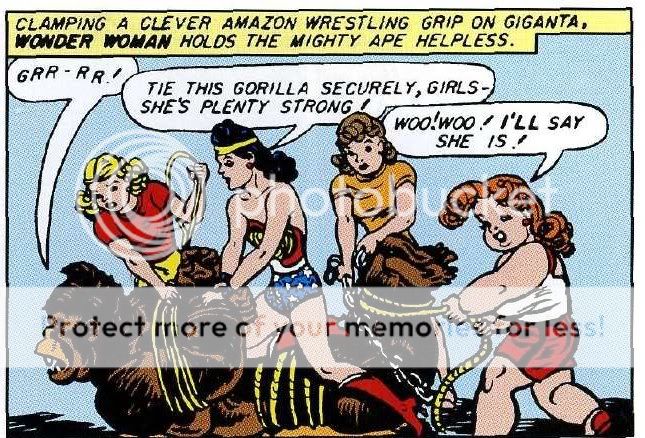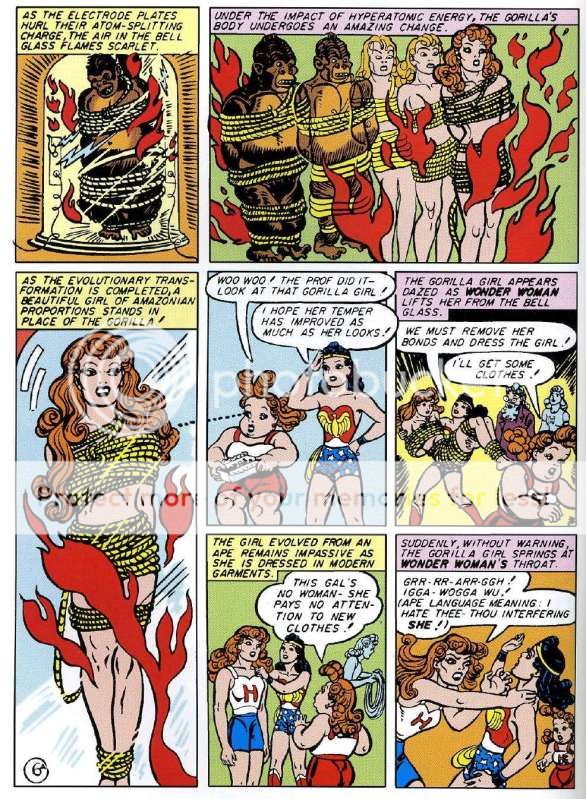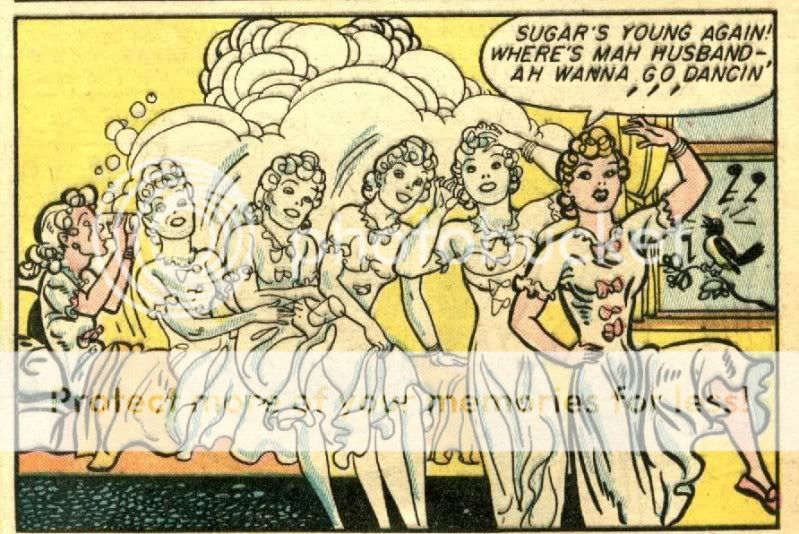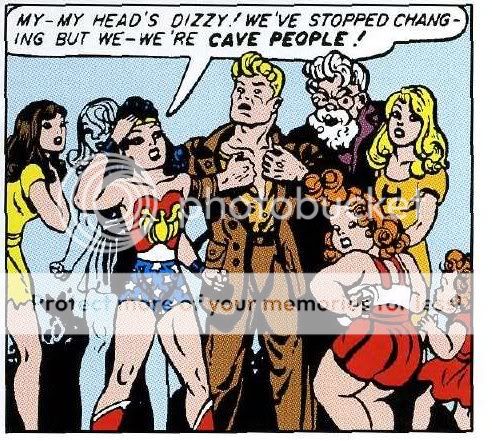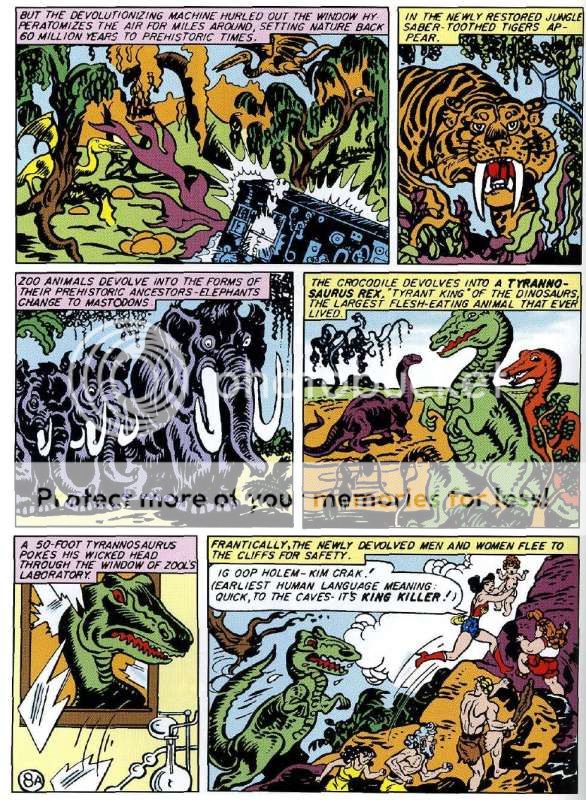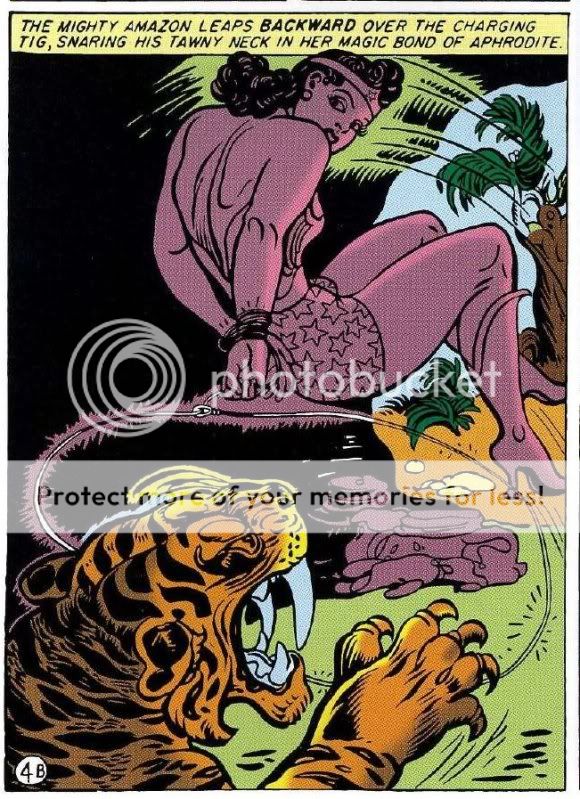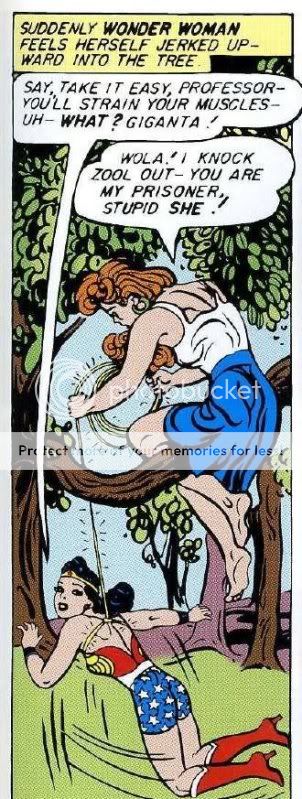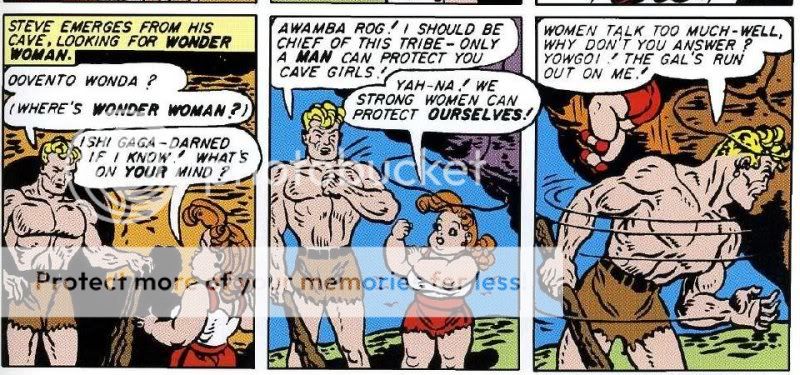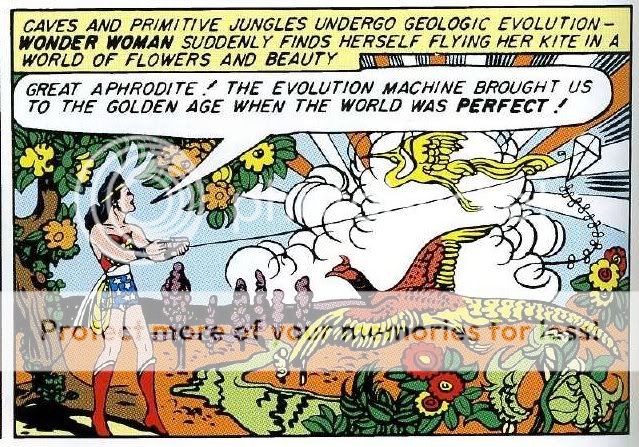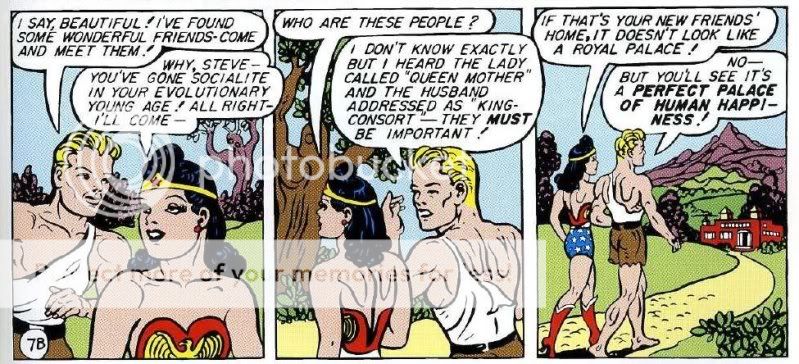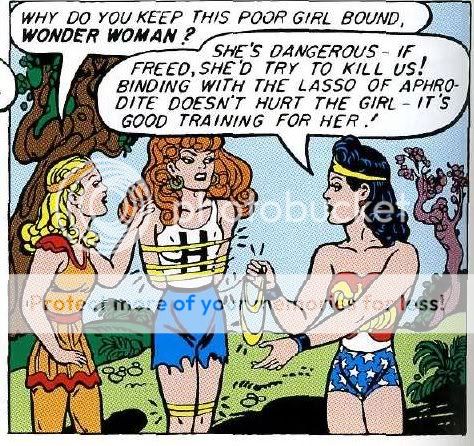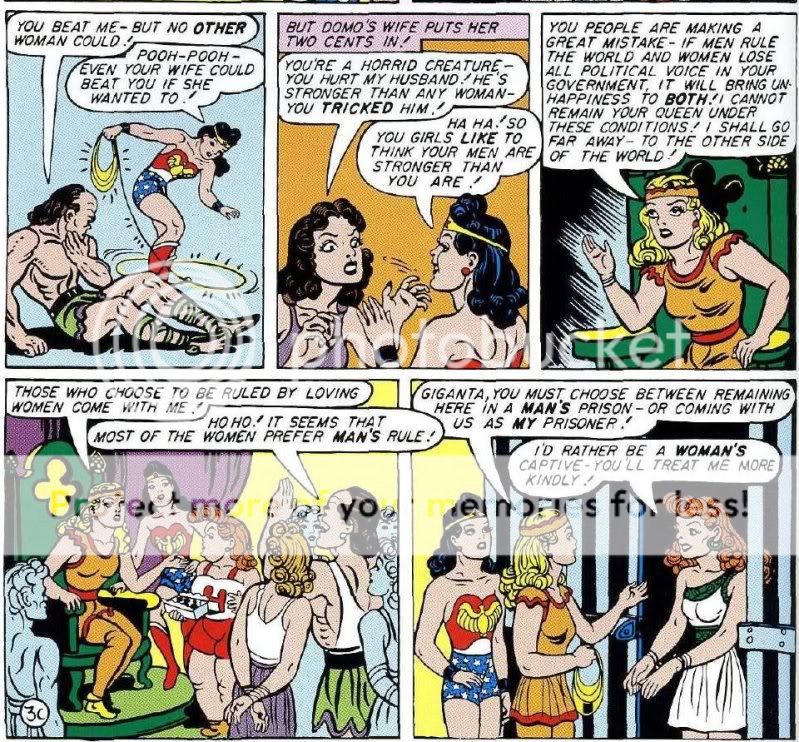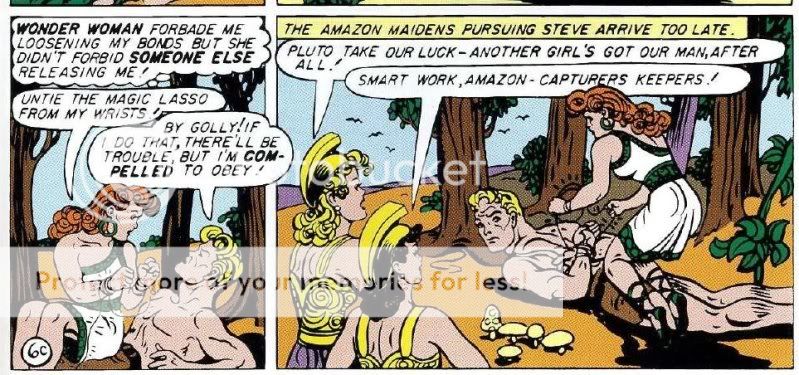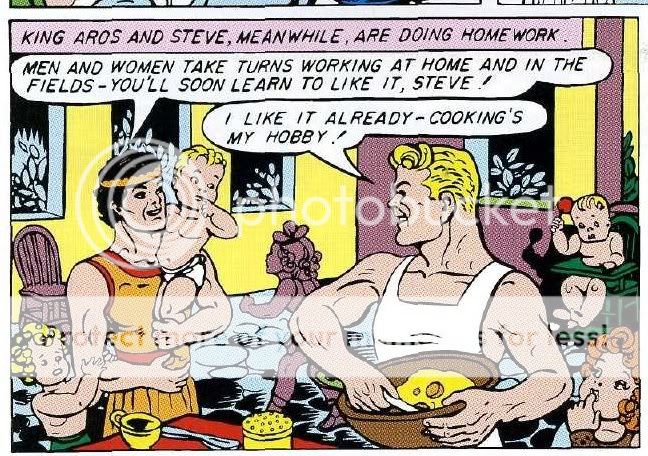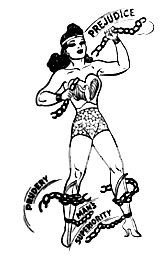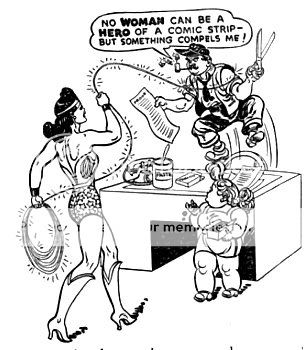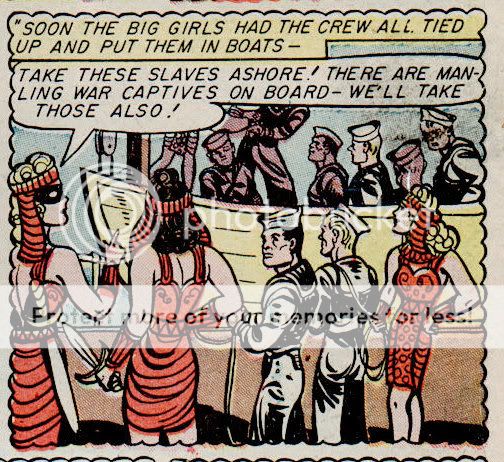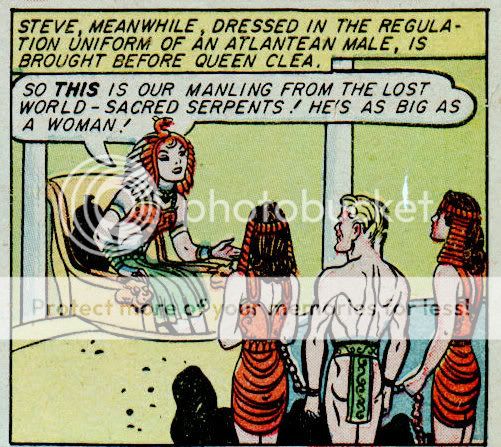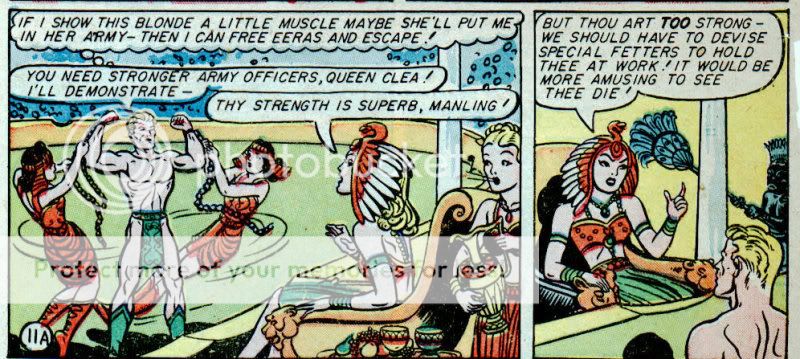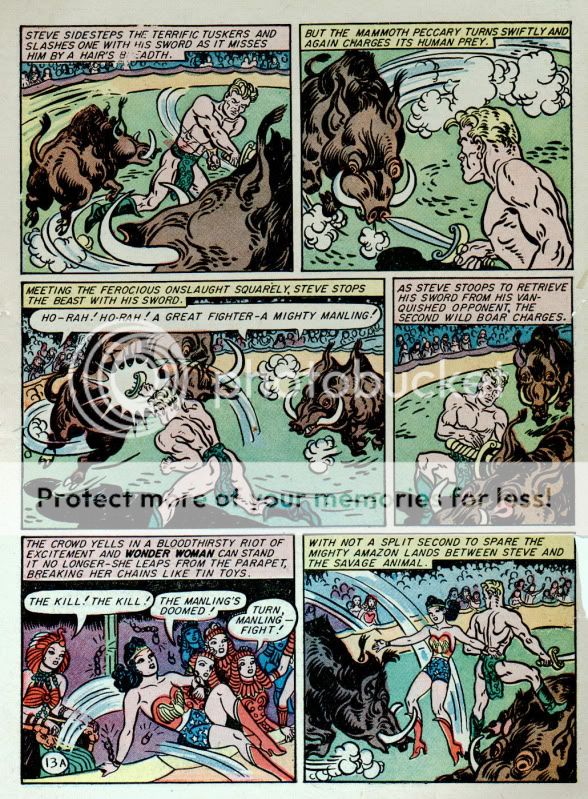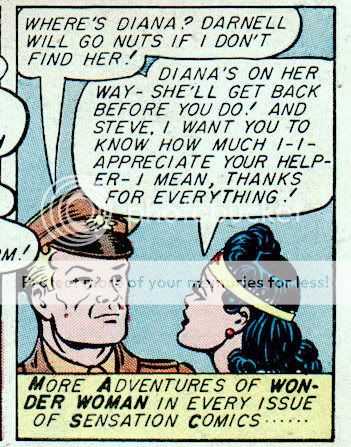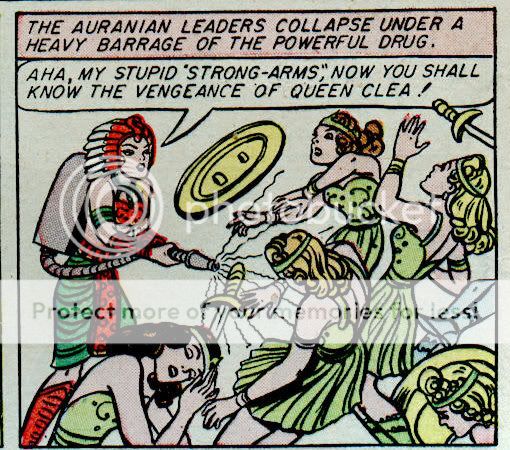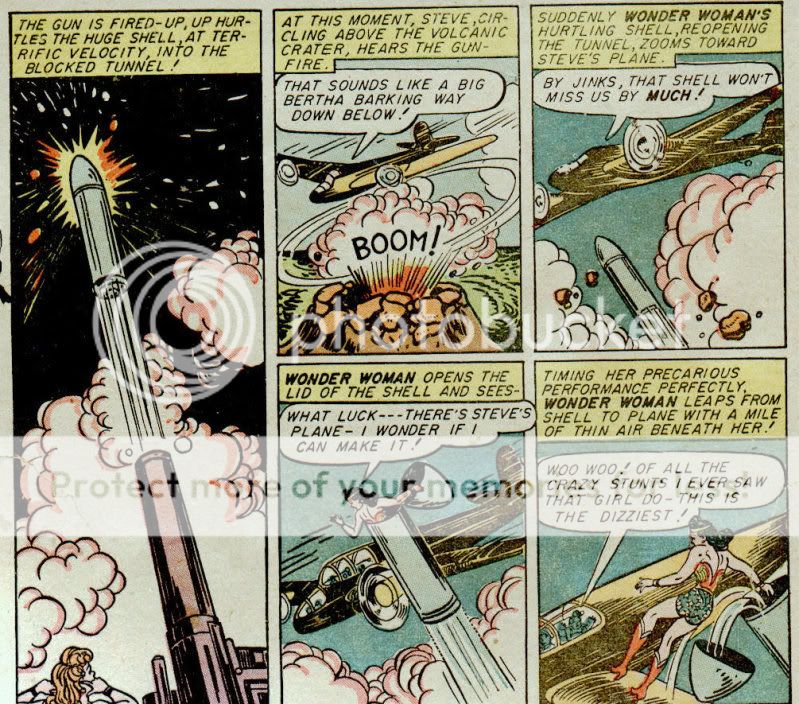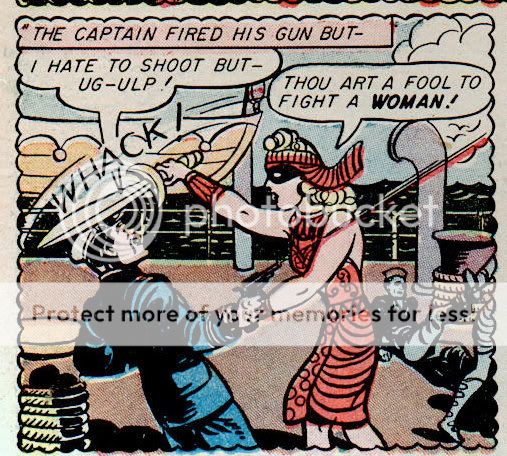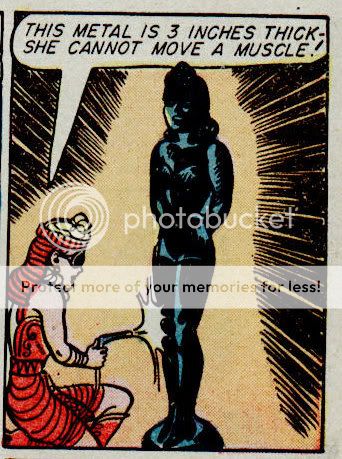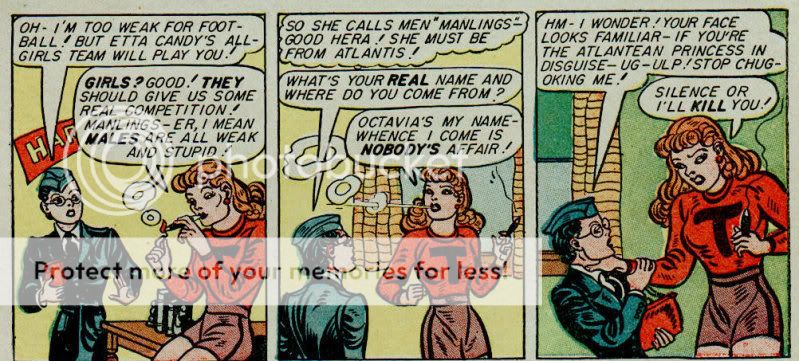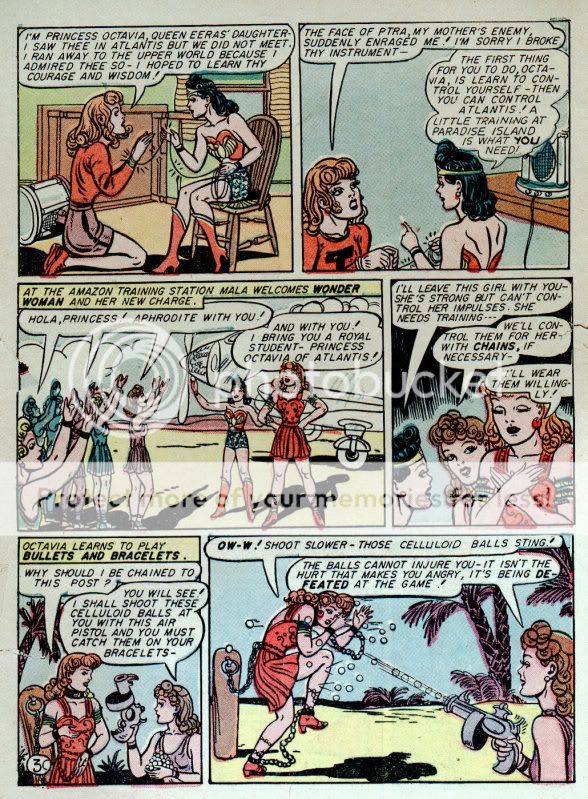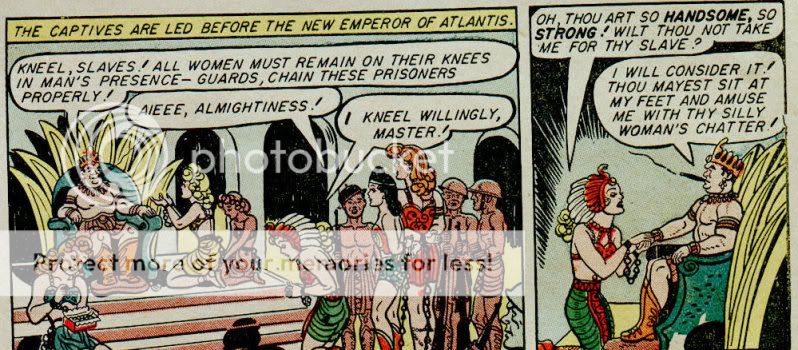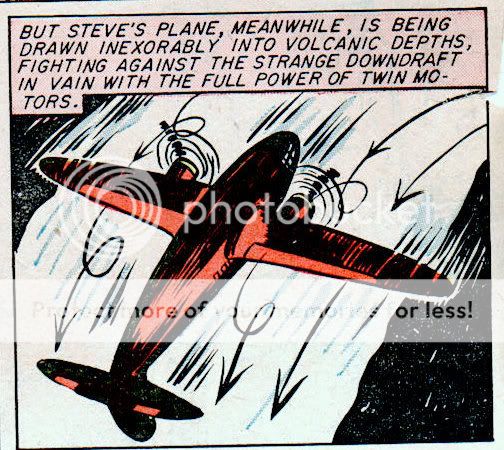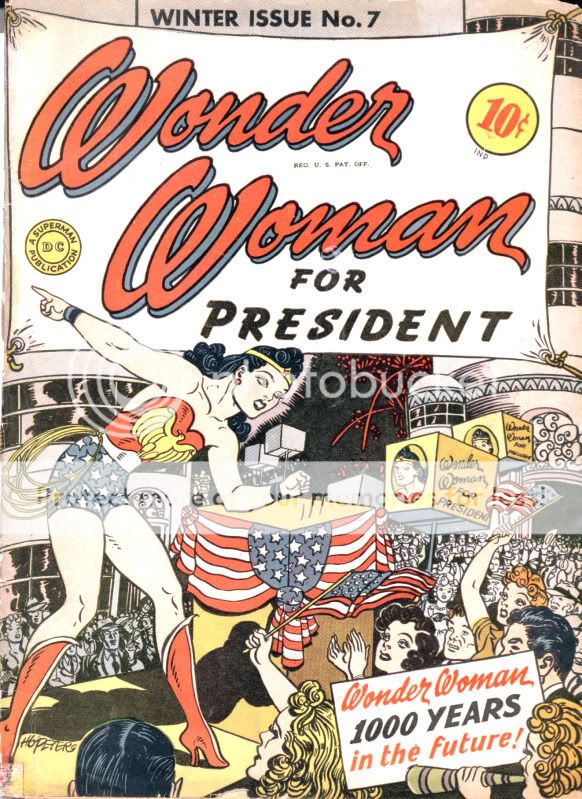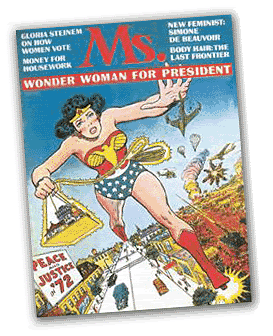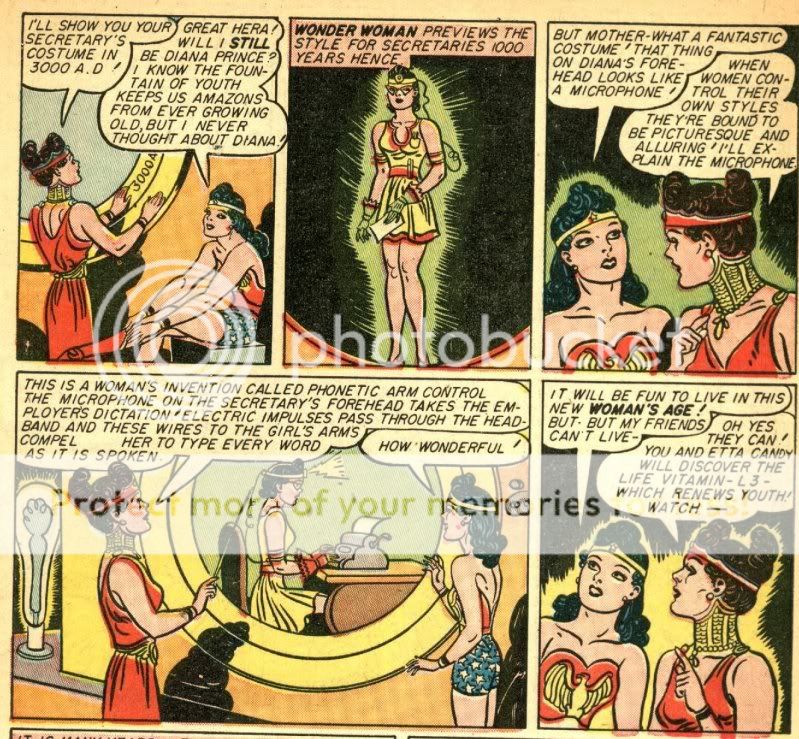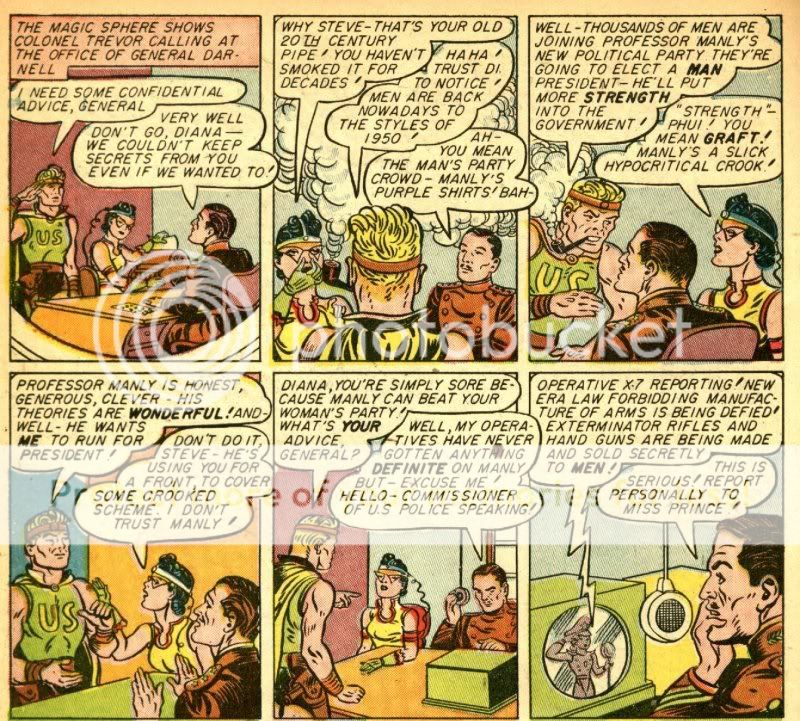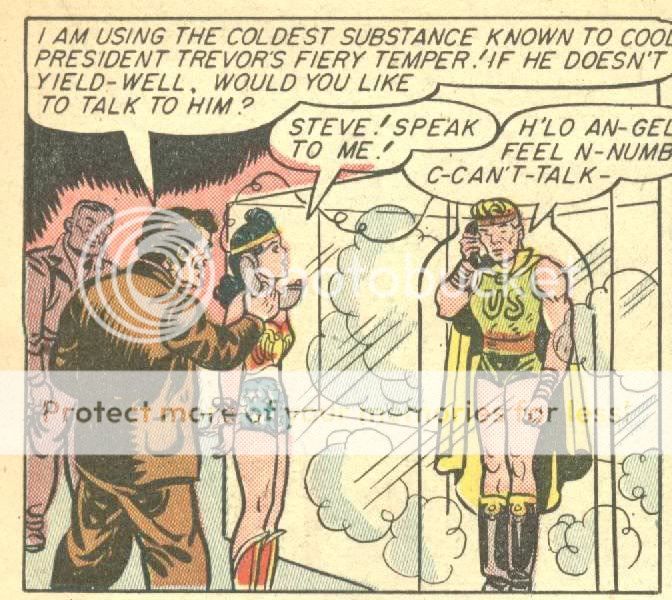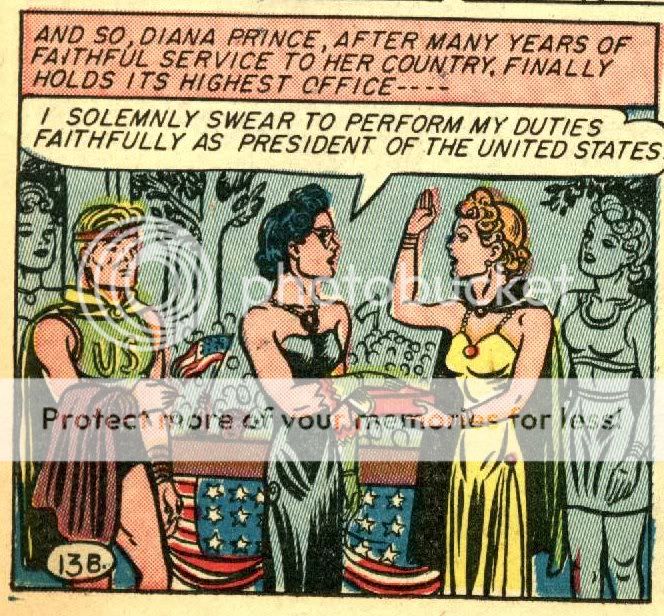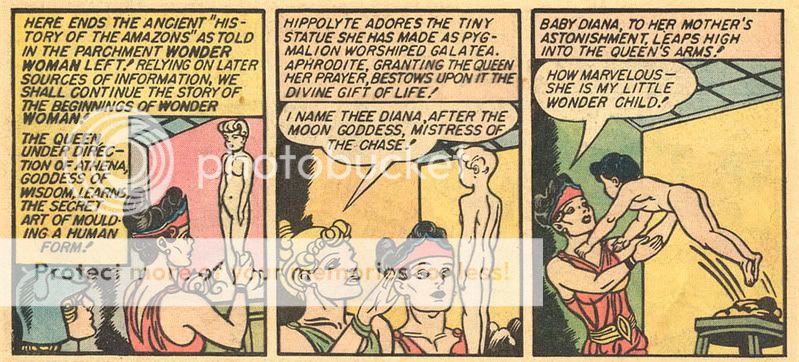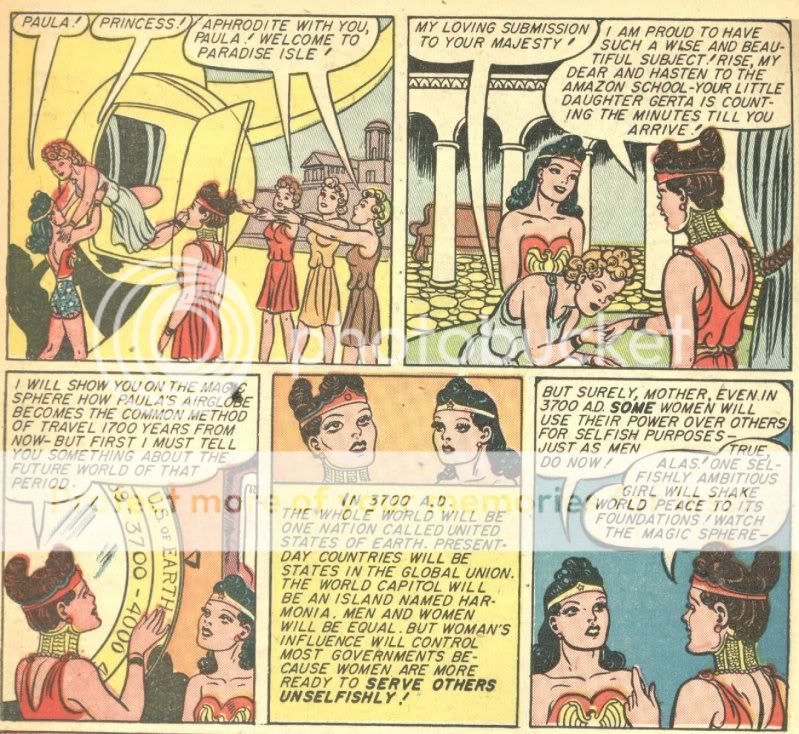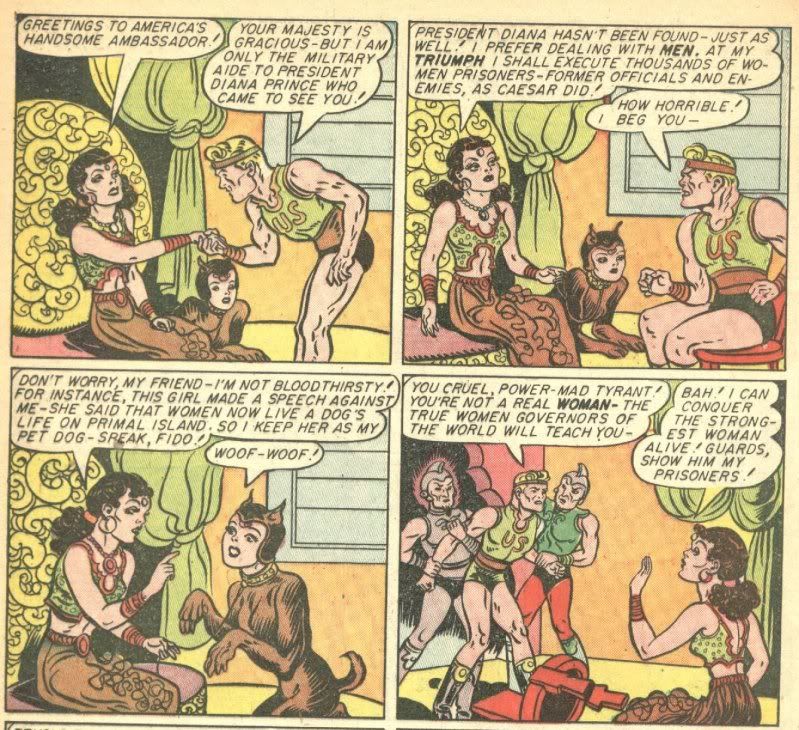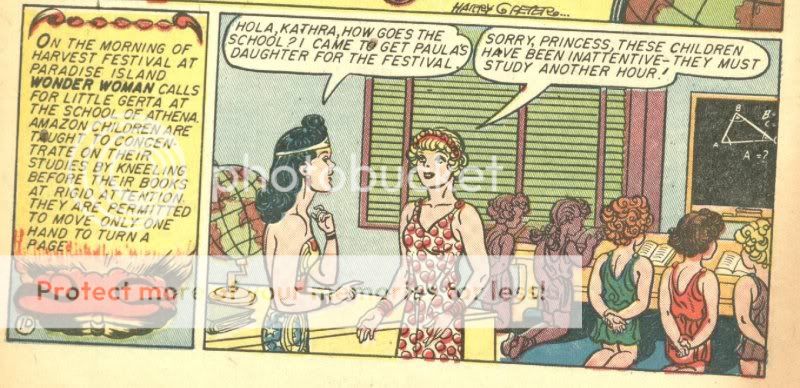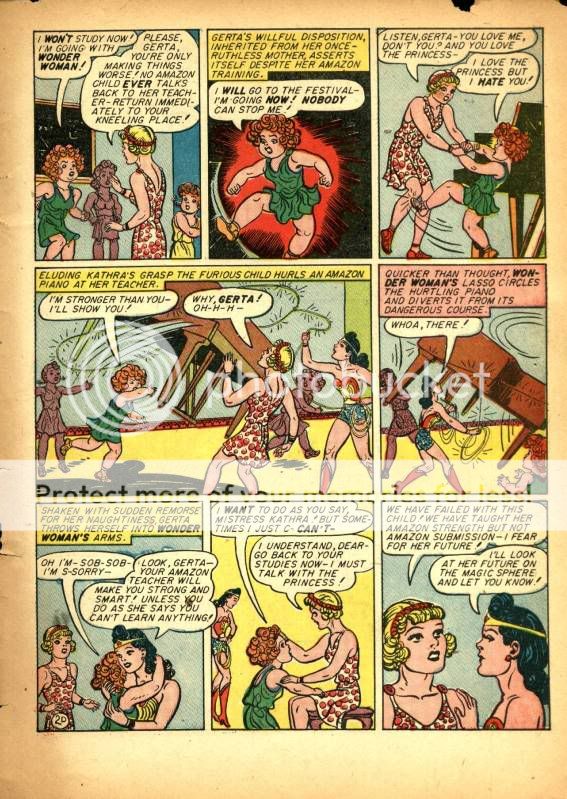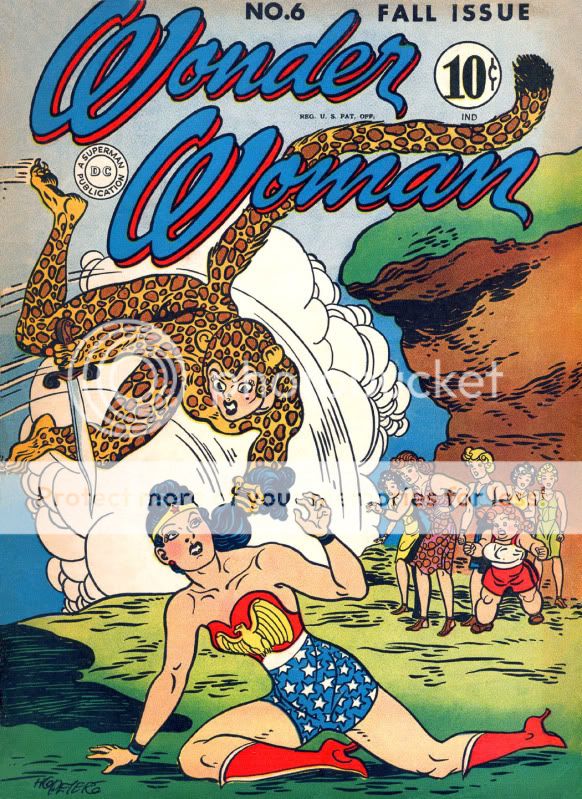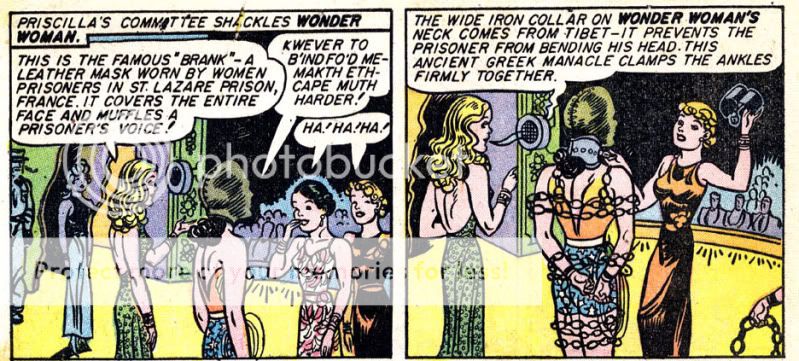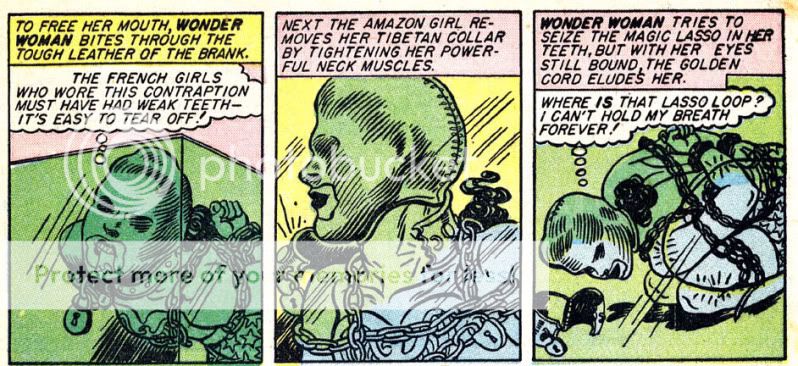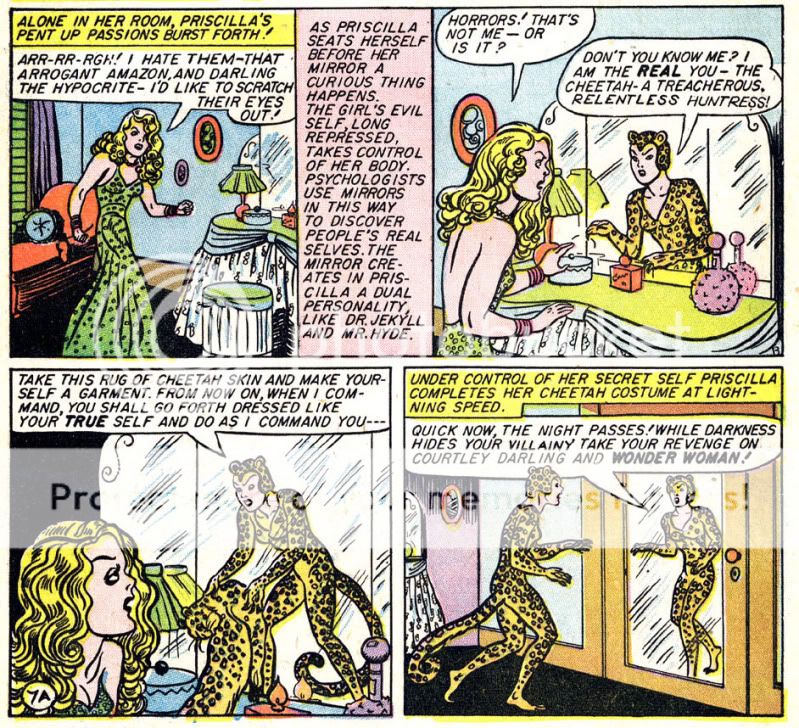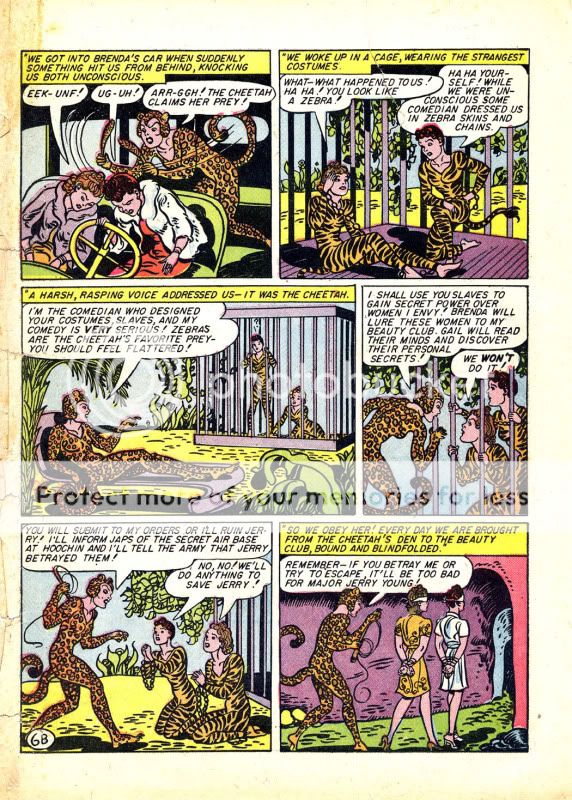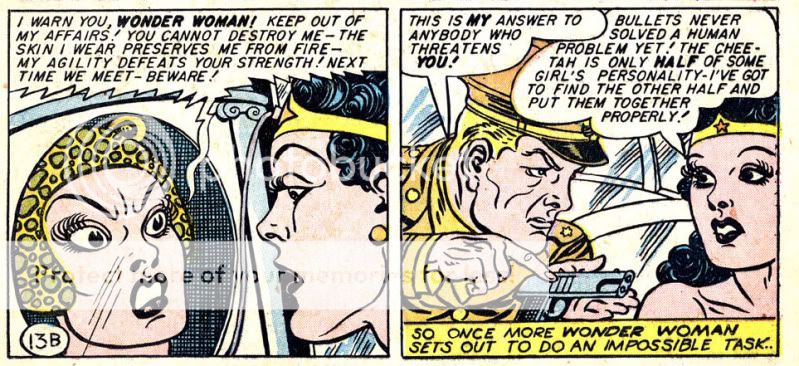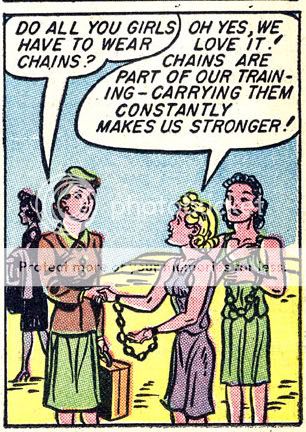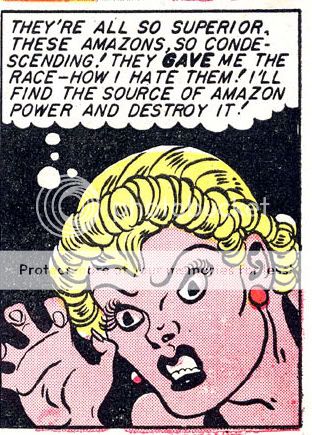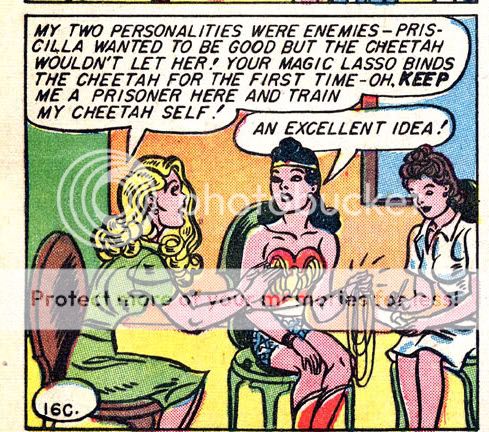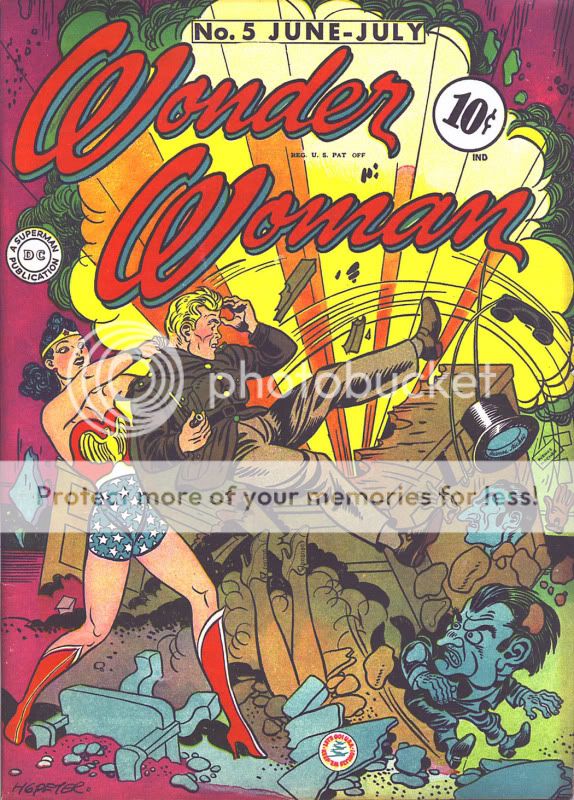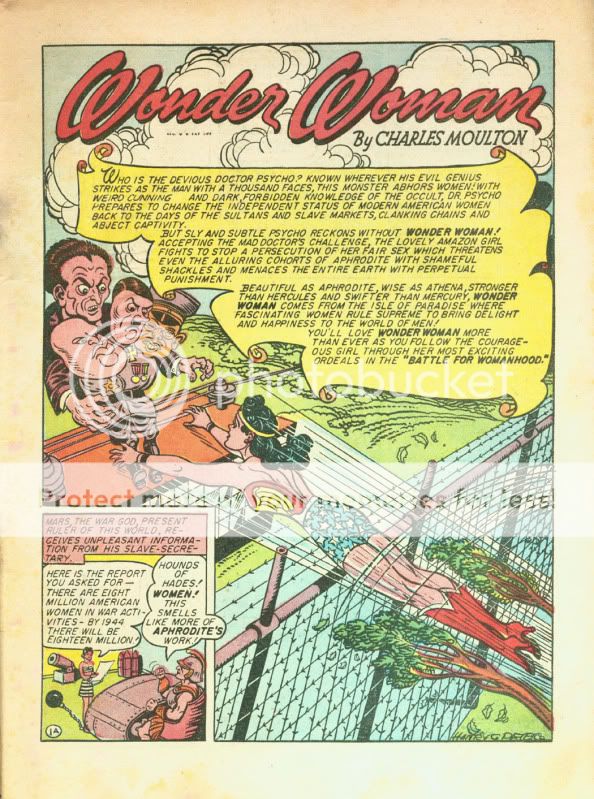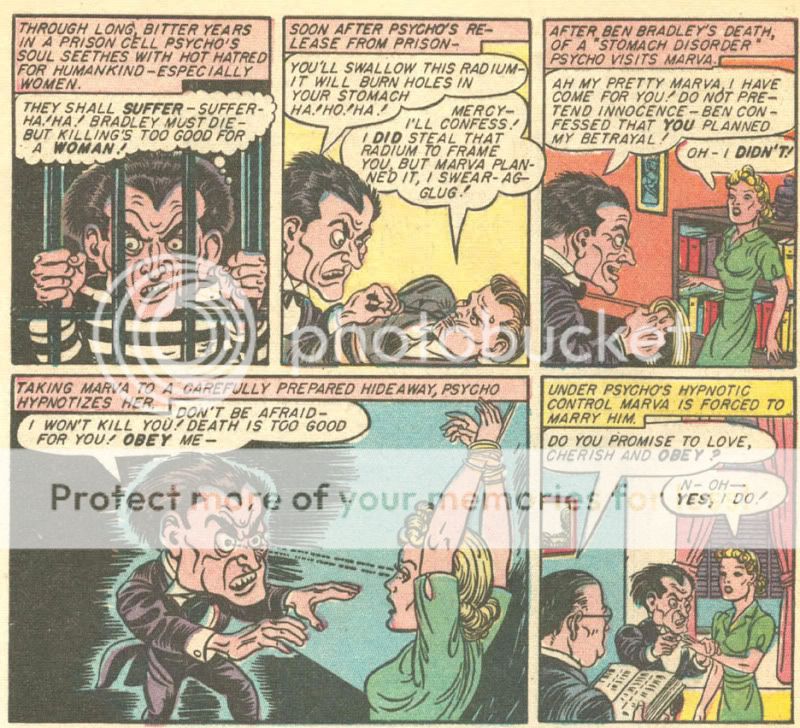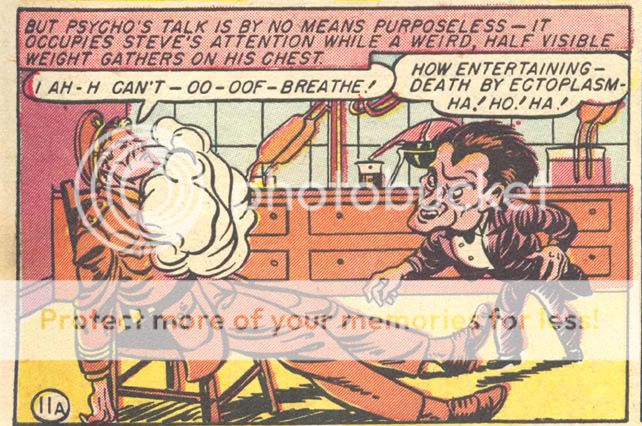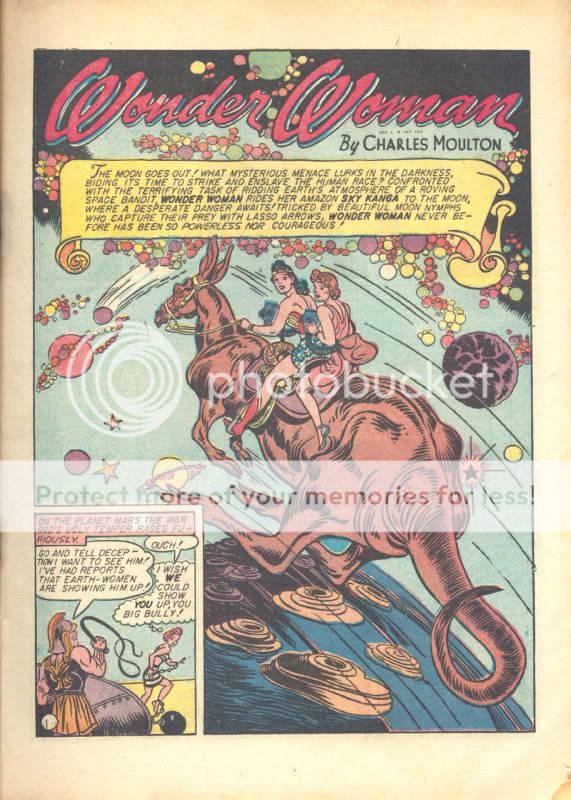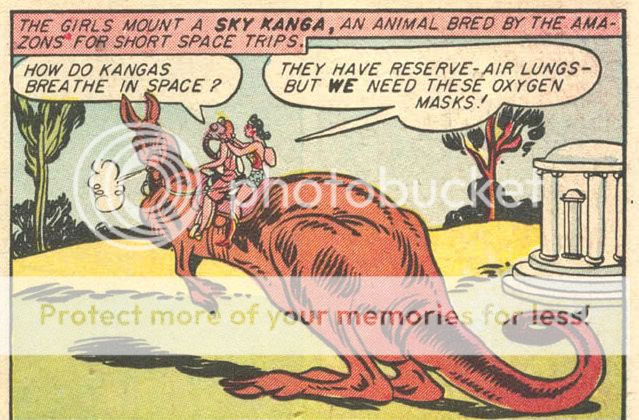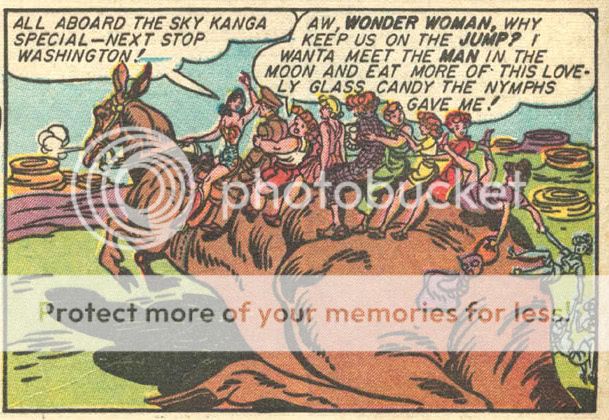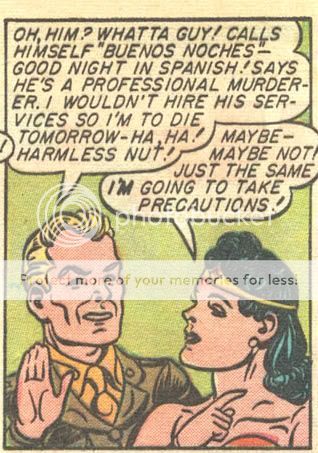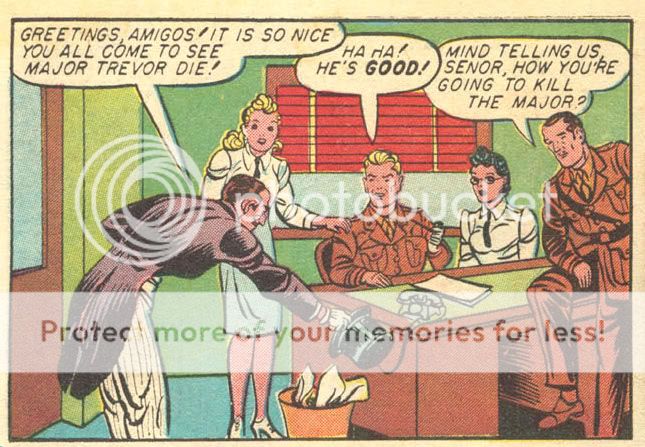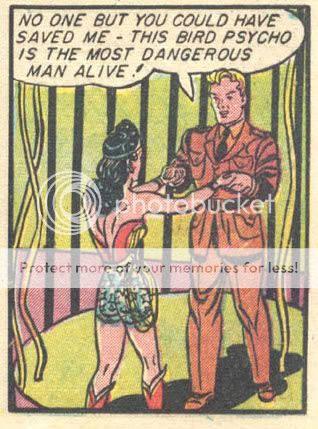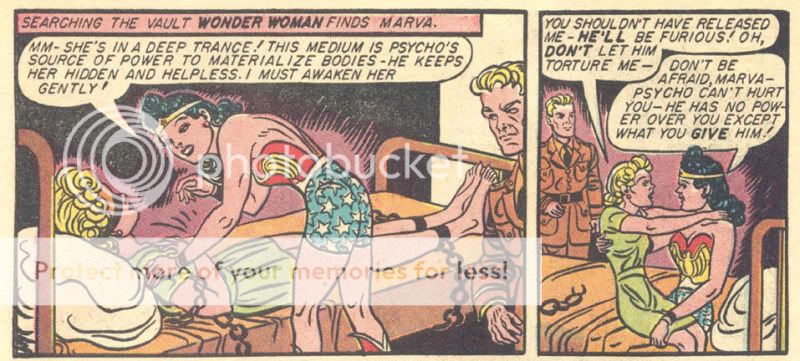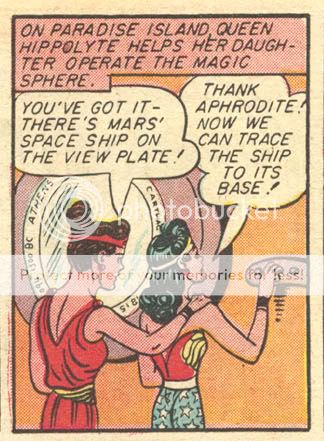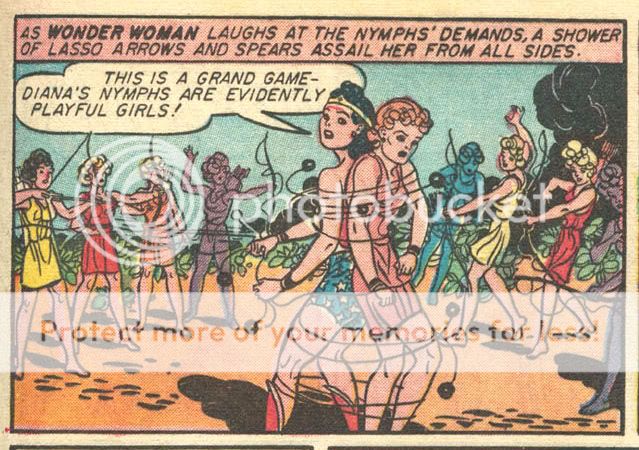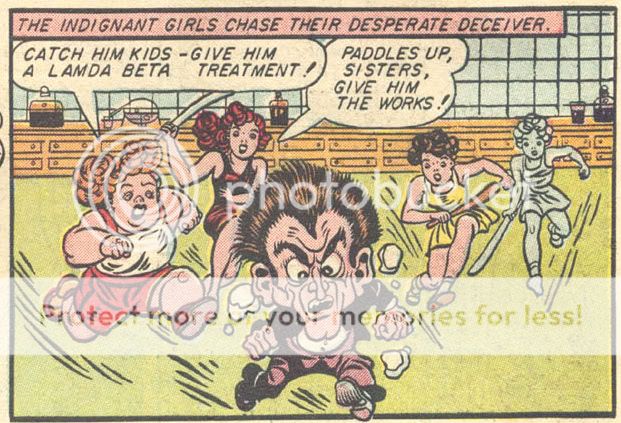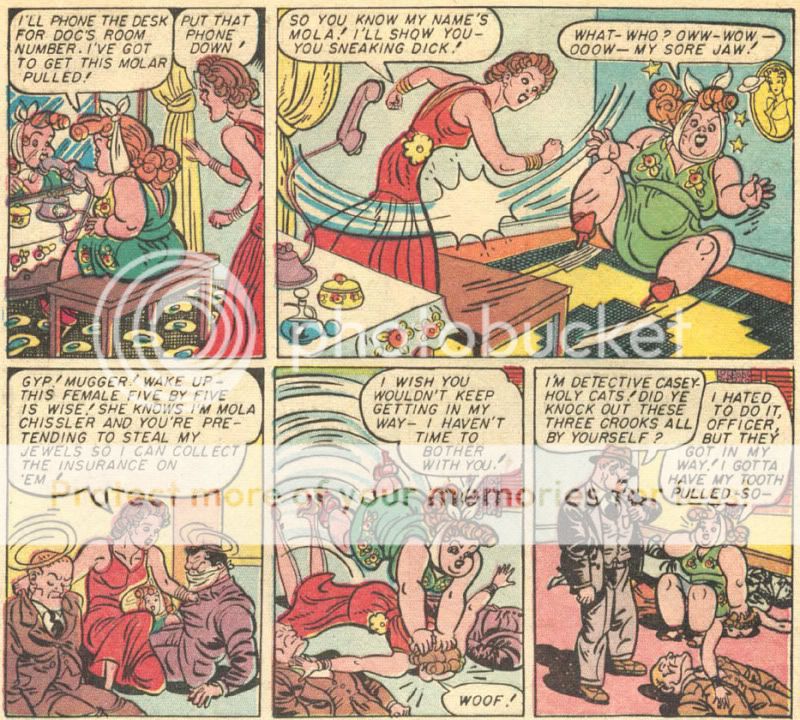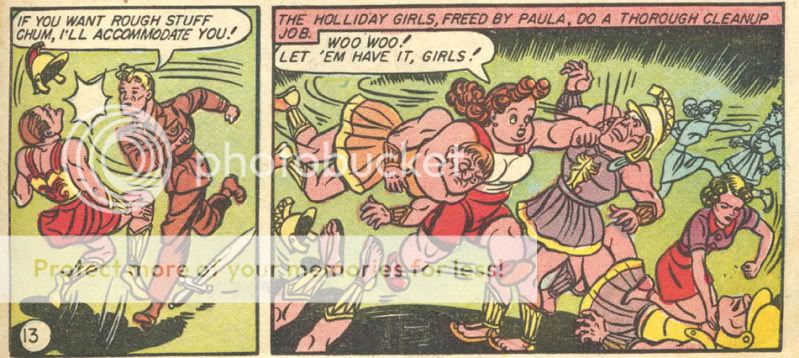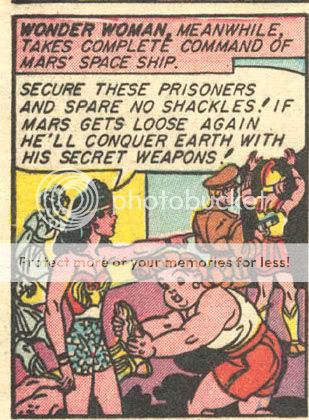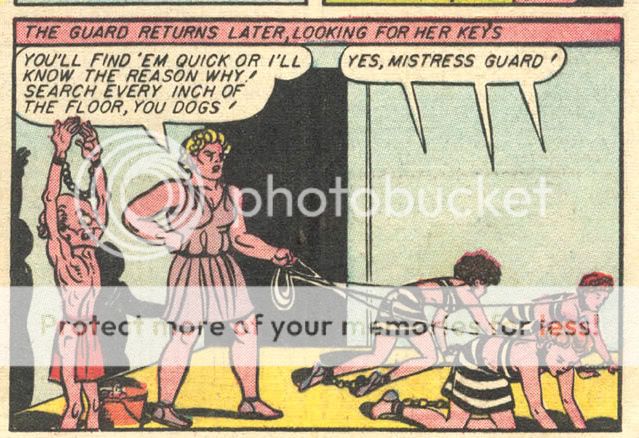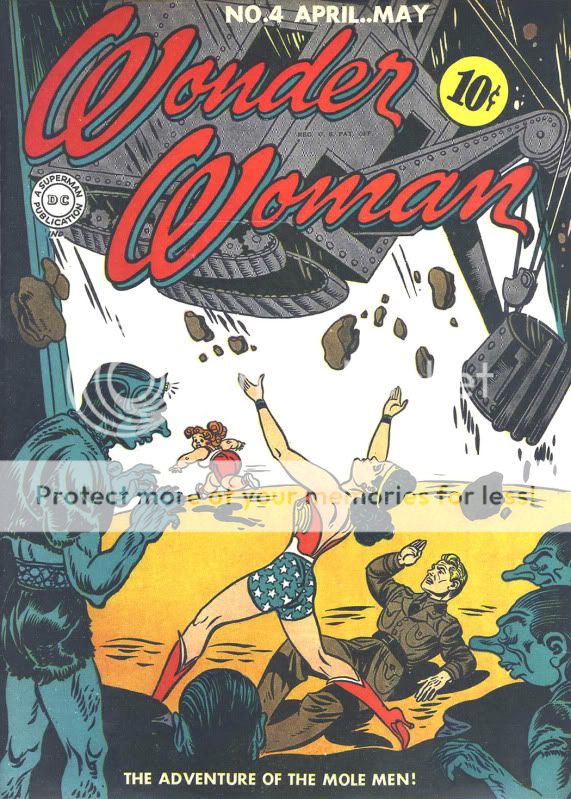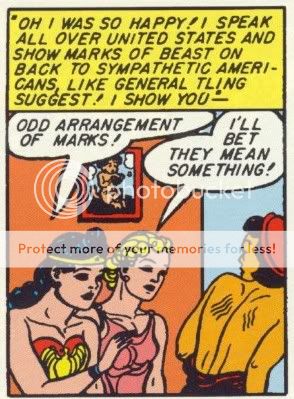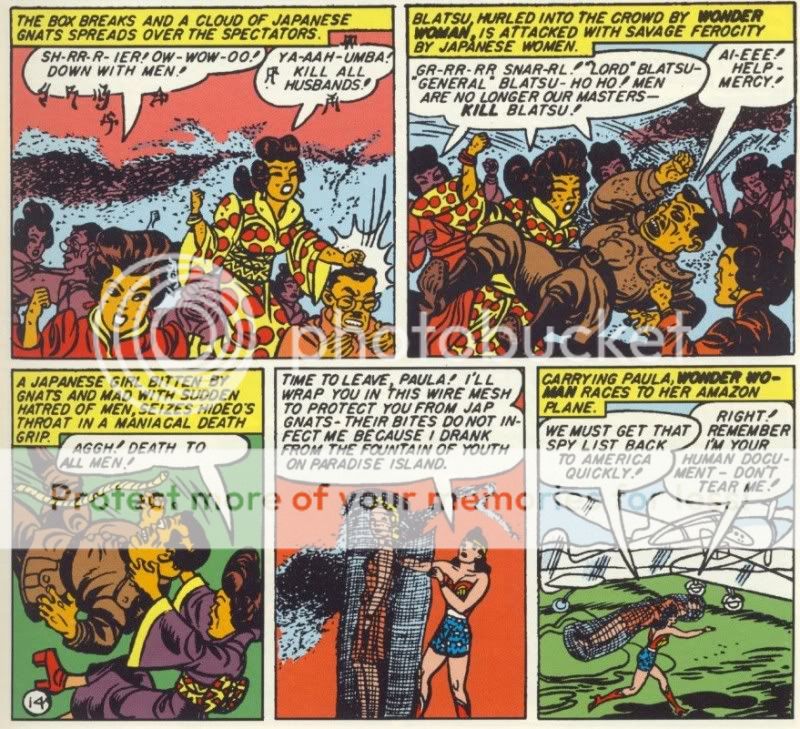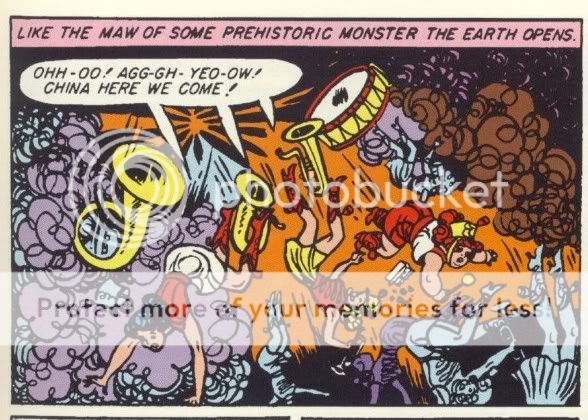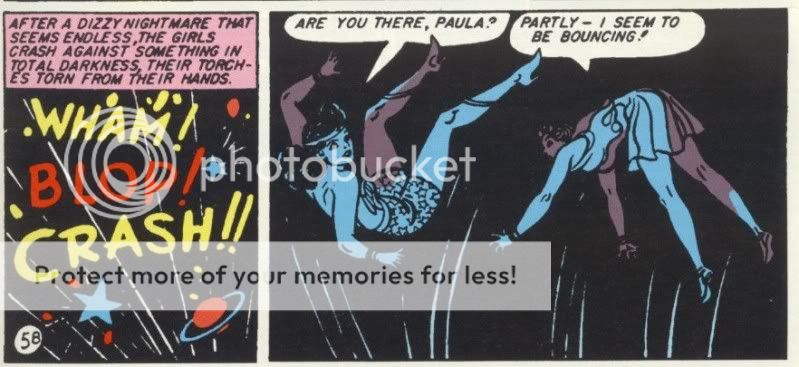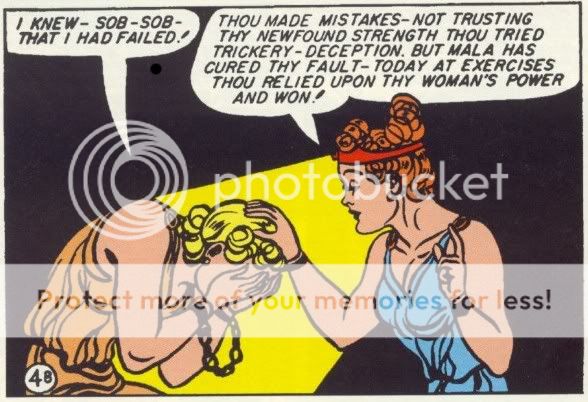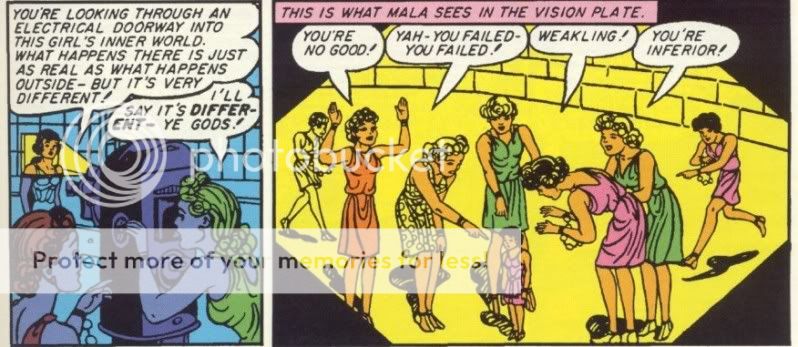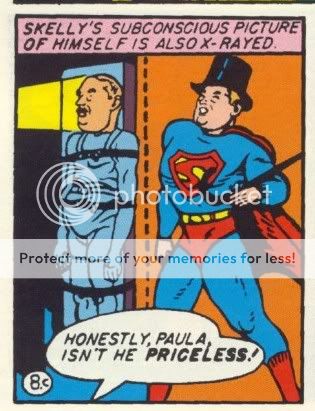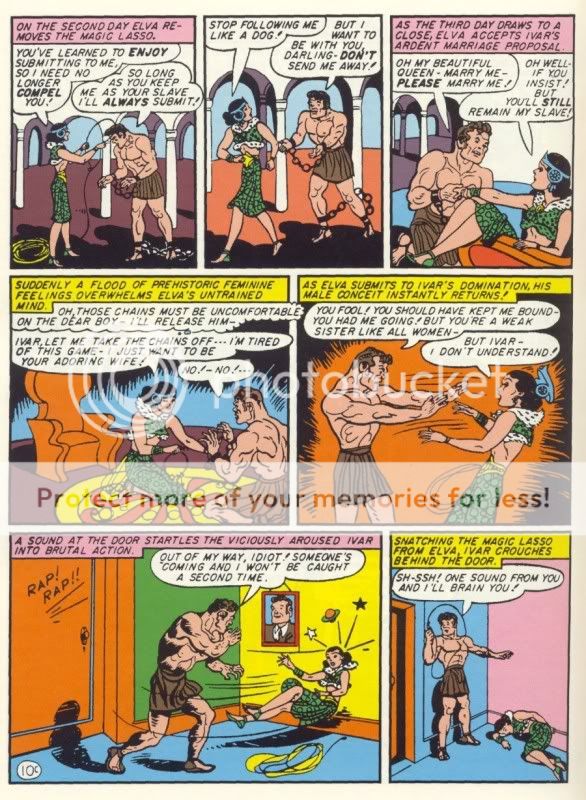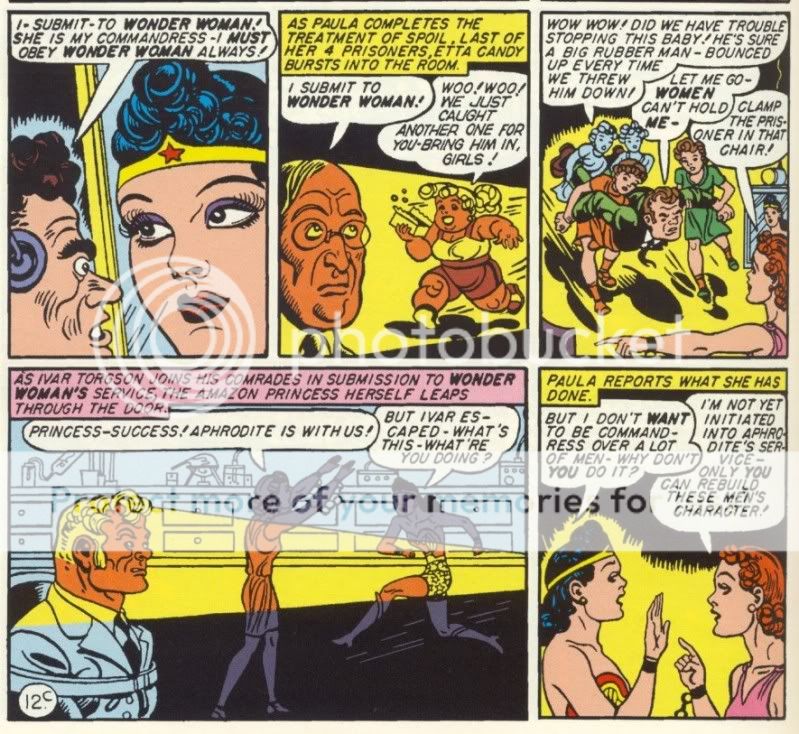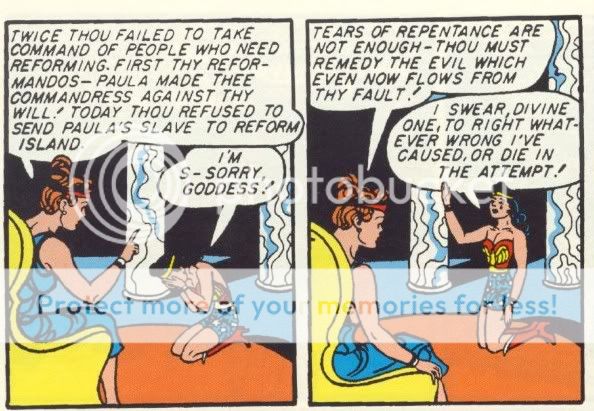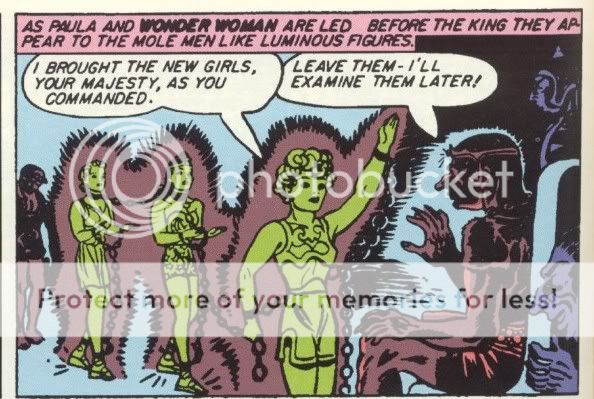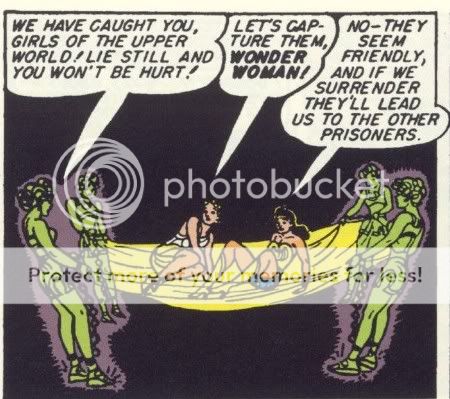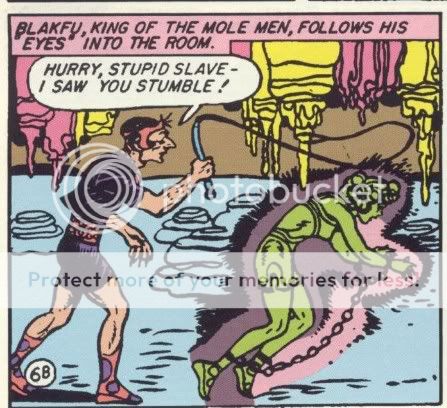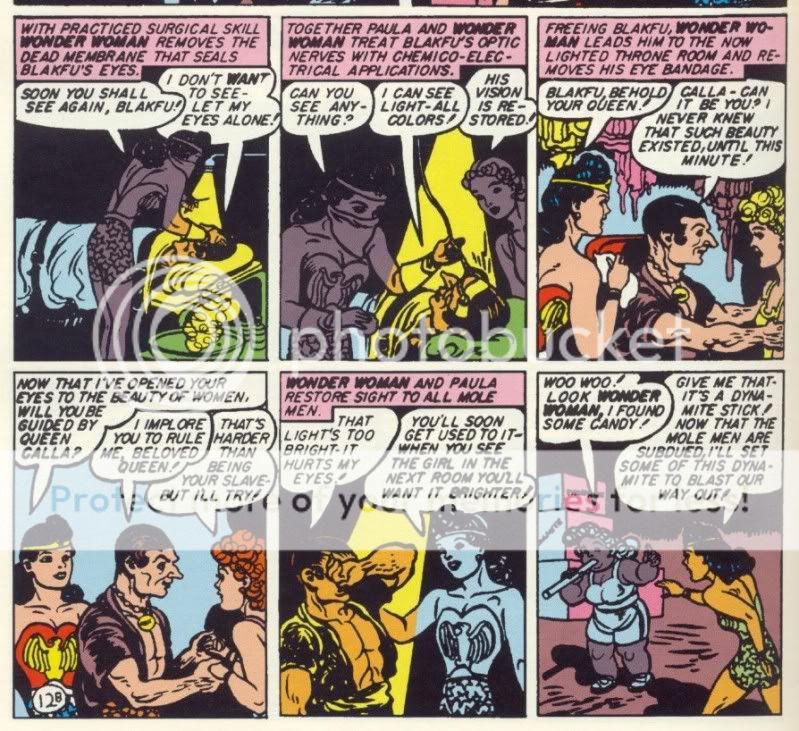Another Peter animal cover. I really can’t get enough of those.
This issue is insane. I mean, sure, you could say that about every issue I guess…but this one really goes the extra mile of nuttiness.
I mean: gorilla bondage.
Need I say more?
All right; so the plot, such as it is, is that Professor Zool of Holiday College has invented an evolution machine, which he pithily calls “The Evolutionizer.” He gives it a test run on a convenient rogue gorilla:
This is the first issue, I think, where Peter’s layouts start to loosen up a little; and the effect is really impressive. That big panel shot of the gorilla woman with the stylized flames, naked except for the rope — I bet Marston studied that carefully. Peter emphasizes the voyeuristic aspect too in the next panel, where Etta’s so impressed that her line of sight busts through the panel borders, and WW seems a bit lascivious as well.
Maybe even more striking, though, is that image at the top of the gorilla evolving. It recalls this image from #7:
I’ve talked a lot over these posts about the relationship between Marston’s fetishes and his feminism. I think there’s obviously a connection there between his fetishes and his utopianism as well. The idea of people, and particularly women, becoming more evolved or perfected is exciting to him…and yes, he thinks turning a gorilla into a human is really hot. I think there’s some sense that he’s thrilling to the idea of a women retaining animalistic characteristics, which is a fairly standard issue fetish (just think Tigra.) But I think it’s also exciting because of the control aspect; the sense of seeing someone change and directing the change. Sociological and psychological liberal do-gooding turns him on.
Though devolving is fun too.
Steve pulling open his shirt as he turns into Neanderthal Steve is fairly priceless, as is Etta posing like a semi-monkey person.
And, hey, WW throws the devolver out the window, and that means everyone can get in on the act…as the entire world (or just the immediate neighborhood? It’s kind of unclear….) is sent back to the past, where we’ve got some beautiful prehistoric fauna for Peter to draw the heck out of:
And how about this:
Yes, you got that right, kiddies; that is Wonder Woman lassoing a tiger backwards with her hands tied behind her back. I’m sorry, but that is fucking bad ass. Peter gives the image what is I think his biggest non-splash panel so far in the series, and it so deserves it. In the first place, the color balance is lovely; making WW a uniform grey really makes the tiger pop. And the tiger itself is unreal; cutting it off at the edge like that makes it appear enormous, and I love the paw; all misshapen bulging knuckles and giant claws. I am in general a fan of Peter’s shoulder-blades and back muscles, and he uses them to fine effect here. Most of all, though, WW’s expression just perfect as she peers over her shoulder. She’s not worried, not even all that intent, just kind of blasé, with that little Elvis sneer, because hell, she lassoes tigers backwards all the time.
Obviously, this is more off the cuff than Alan Moore’s Rorschach stunts or even than Frank Miller’s Dark Knight why-do-I-wear-a-target-on-my-chest, but it has some of the same “holy shit!” pulp cool about it. It’s not something Marston and Peter generally manage, or even try for in quite this way, but they do nail it here.
Did I mention it’s really hot, too? Or have I just been reading too many of these things?
Anyway, speaking of inappropriate interests, back in the evolutionary past there are — what do you know? — evil masculine tree people who like to tie women up. Giganta (that’s the gorilla-turned-woman) learns a trick or two from them and…well, you know what happens.
That’s a superb panel too. It’s the linework on Giganta’s dress, and the way she’s hunched and her crossed legs, and that tree just underneath her in the background, that looks like it was scribbled by a child.
Even beyond catering to his usual fetishes, though, Marston is clearly having a blast and a half; the devolution gives him and Peter an opportunity to dabble in some broad slapstick….
As you can see in that second example, Peter delights in having the characters talk in a ridiculous pidgin caveman dialect. He also, and a little uncharacteristically, decides to mock both ends of the gender war. Etta claims women are strong enough to care for themselvs; Steve says women need men to protect them; both have their pretentions to competence slapped down with vaudeville aplomb. (Though, of course, in the end women win, since it’s WW who saves the day.)
Anyway, eventually they re-evolve, though not all the way. Instead of getting to modern times, they end up in — well, let WW tell you:
Yes, it’s the evolutionary golden age when everything was perfect. The sun always shines, birds flit about, the rich live in hovels because they’ve given all their goods to the poor, Etta loses weight, and Steve is transformed into a bishonen Edwardian metrosexual.
It’s hard to know exactly what Marston is thinking here. Surely his grasp of history isn’t this poor, right? I said right?
Be that as it may, I assume this era he’s talking about is supposed to be the much-vaunted but probably entirely fictitious anthropological matriarchal age. In any case, the golden age is, of course, ruled over by women, who are wise and good, but who, unfortunately, don’t yet understand the joys of forcible restraint.
So Giganta gets free and wreaks havok, the upshot of which is that men decide they want to rule instead of women, on the grounds that men are stronger than women. So WW beats the tar out of the lead male guy who has a caveman forehead. However, that doesn’t quite settle things:
For Marston, women are actually stronger than men, but they like to pretend that men are stronger, presumably for romantic/sexual reasons.
From a feminist perspective, you can see where this might be maybe a problematic position. On the one hand, Marston is claiming women are superior (even in physical strength.) On the other, he seems to be arguing that their oppression is their fault.
There’s an article I stumbled on over at the League of Substitute Super-heroes (I couldn’t find the author’s name) which goes off on this point:
On a more complex level, Marston was not a feminist because he believed women were the keepers of men through their sexuality. Ignoring the rampant heterosexism in such an idea (not to mention the disturbing idea of blaming others as an entire group for the behaviours of other individuals or groups) making women responsible for men’s problems is a trait Marston shares with most misogynists, whether they are the Promise Keepers, backlash “Femme-Puppets” 2 or even the religious wowsers who would be deeply opposed to Marston and his lifestyle if the man was alive today. He believed that, “Normal men retain their childish longing for a woman to mother them” and that “[a] woman’s charm is the one bond that can be made strong enough to hold a man against all logic, common sense, or counterattack.” This is a dangerous position to hold in regards to gender relations, though in Marston’s case, one probably borne more out of ignorance and privilege than outright malice. To come out in the 21st century and tell a domestic abuse victim that all she needs to do is use her “feminine allure” more on her husband is mind-boggling, but from Marston’s point-of-view, it would be the chosen response. Never mind that victim-blame is the great feeder of the mentality that causes most domestic violence and gender-related violence in society. The manifestation of this attitude in the Wonder Woman comic series was the tokenism of Steve Trevor, always being “rescued” by his girlfriend, much the same way as Lois is always caught by Clark after plummeting through the air for a bit as she is so often found doing. Both cliches are two sides of the same misogynistic coin.
As I said, there’s definitely something to that. But on the other hand…I mean, Marston seems to be suggesting, at least in this comics sequence, that domestic abuse victims should slug their husbands and tie them up…which maybe wouldn’t work ideally either, but isn’t quite as squicky, at least (or differently squicky, anyway). In addition, a big part of the point here really seems to be an argument about false consciousness. That is, Marston identifies the problem as women downrating themselves (for whatever reason); he wants women to realize that they’re as good as men, or better than men. And he’s also got a very explicit statement that women need to have political power for everyone’s sake…which was the argument women used towards the beginning of the century when they were trying to get the vote (women’s vote was supposed to abrogate a number of moral evils, including drink — temperance and suffrage were closely linked.)
I actually think that claiming women are morally superior to men is a really problematic strategy for feminism — I don’t think it’s true, for one thing, and the distance between rhetoric and reality can be painful. The suffragette movement in England, for example, ended in unhappy success; they did get the vote, but he social transformation they promised because of that didn’t happen, which caused a fair amount of bitterness within the movement. Though, on the other hand, the promise of moral rejuvenation was an effective one in rallying groups who might not otherwise have been interested in women’s political fortunes…basically, all radical movements have to overpromise if they’re going to succeed.
Feminism, or any movement for oppressed people, has always got a tension around the issue of victimization. On the one hand, of course, you need to point out that you are victimized, and emphasize the injustice and how it needs to be changed. On the other hand, nobody likes to see themselves as a victim, and if you emphasize victimization too much, you can end up arguing that your oppression has essentially broken you and made you incapable of equality (this is what happened to slaves following the Revolution; the argument about oppression ended up being used against them; it was claimed they “weren’t ready” for freedom, an argument which was used to justify another hundred years of oppression.) So you need to have a positive vision too; you need to say “Black is Beautiful,” or women are moral beacons, or whatever — you have to say that your particular experience or essence is valuable. But if you go too far in this direction, then it becomes unclear what you’re complaining about, exactly…if oppression hasn’t harmed you, if you’re better off than your oppressors, then why should the oppressors even consider themselves oppressors?
So, yes, Marston is pretty far out on one end of that debate, and it causes real problems when he tries to analyze oppression. And it’s worth pointing that out. But on the other hand, what he really sees himself doing in WW, I think, is encouraging girls to value themselves, and I think that, you know, that’s probably a worthwhile goal as well. Improving self-esteem in girls could even have positive effects on domestic abuse statistics down the road, at least arguably.
Also, I have to say, Steve being rescued by a woman is pretty different than Lois being rescued all the time by Superman. The essence of sexism is disproportion. It means something different to have genre conventions fulfilled (by having a man rescue a woman) and to violate them (by having a woman rescue a man.)
And, anyway, Steve isn’t always rescued by his girlfriend. Sometimes Etta rescues him.
Well, I’ve nattered on kind of endlessly. Let’s finish up; everyone eventually evolve all the way up to ancient Greece, at which point Wonder Woman meets her mom before she (WW) was born, which is sweet, I think. Also, Steve is hunted as a husband by hordes of rope-wielding Amazons.
I like Giganta’s reasoning there, too; masochists love legalistic loopholes in their bondage contracts. Or that’s what Deleuze tells me.
Oh yeah, and Wonder Woman fights Achilles and beats him. And then she unties Steve:
That’s a cute, sexy little flirtation: I can almost see there why one commenter on an earlier post said that Steve and WW actually seem to like each other. Though, of course, the punch line is that you can’t both save the world and get married. That’ll show me for defending Marston’s feminist bona-fides, I guess. Did he really believe that wives needed to stay home and tend to their husbands? On the one hand, both his wife and their mistress worked at various points. On the other hand; his female President in WW#7 and his female ruler in this issue both appeared to be unmarried. I guess when you’re married you need to keep your husband in line full time; it’s only when you’re not tied down to one guy that you can go off and rule them all. Though the mole men seemed to eventually agree to some sort of collective government by their wives…. And his golden era includes a proviso that men and women divide work in and out of the home equally….
In any case, I’ll try to pay a little more attention to Marston’s views on marriage in the issues I’ve got left — only 19 to go….


